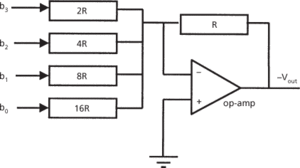The electronic hardware used in the control of processes that converts a digital signal to an analogue signal such as electrical voltage or current.
See D/A converter.
A device/circuit/IC that converts a discrete binary signal into a continuous analogue signal. A simple DAC can be built up from a series of weighted resistors. Taking a 4-bit binary word, B = b3b2b1b0, the most significant bit (b3) is connected to a resistor of value 2R, bit b2 to a 4R resistor, b1 to an 8R resistor, and so on. The value of the resistor doubles for each less-significant bit. If any bit is at logical 1, a voltage is applied across its resistor and a current inversely proportional to the resistor flows. An operational amplifier circuit can be used to sum the currents and produce a voltage proportional to the total current flowing. The magnitude of the voltage will therefore be directly proportional to the value of the binary number B.

4-bit digital-to-analogue converter
- Buys Ballot’s law
- buzz
- buzzard
- BV photometry
- BW
- BWG
- BWR
- Bw star
- BWTP
- BY Draconis star
- Byerlee’s rule
- bygones
- Bykovsky, Valery Fyodorovich (1934– )
- Byng, George, Viscount Torrington (1663–1733)
- BYOD
- by-pass capacitor
- bypass capacitor
- by-product
- Byron, Augusta Ada
- byssate
- byssus
- byte
- byte-addressable
- byte code
- byte-order mark